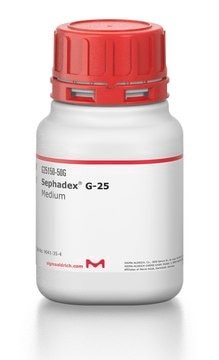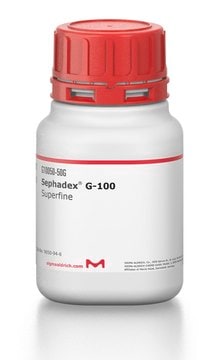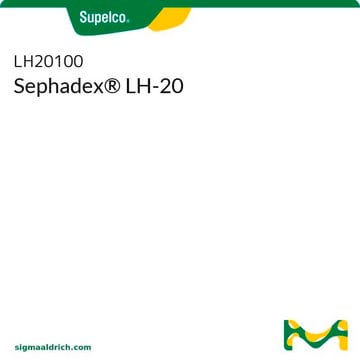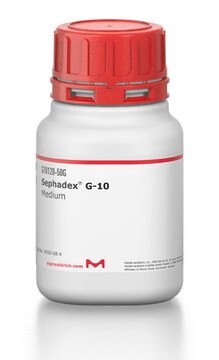Recommended Products
form
slurry
technique(s)
LPLC: suitable
matrix
Agarose
matrix active group
polymer
swelling
1 g swells to 15-20 mL gel
bead size
40-120 μm
separation technique
size exclusion (SEC)
Looking for similar products? Visit Product Comparison Guide
Related Categories
General description
Sephadex® is composed of repeating glucose units attached by α-1,6 glucosidic bonds. This structure ensures more aptamer binding sites and greater binding capacity. It is suitable for large-scale purification and is considered stable and can be utilized more than once.
Fractionation Range (MW)
Globular Proteins: 4,000 - 150,000
Dextrans: 1,000 - 100,000
Fractionation Range (MW)
Globular Proteins: 4,000 - 150,000
Dextrans: 1,000 - 100,000
Application
Sephadex®G-100 is a gel filtration medium used in protein chromatography, affinity chromatography and gel filtration chromatography
It has been used:
It has been used:
- in gel filtration column for α-amylase purification
- in gel filtration column for the purification of polysaccharidic fraction extracted from the skin of the ray Raja radula
- to remove excess protamine by size exclusion from cross-linked iron oxide (CLIO)-protamine-linked (B) peptides
Other Notes
G100120-100G′s updated product number is GE17-0060-01
Legal Information
Sephadex is a registered trademark of Cytiva
replaced by
Product No.
Description
Pricing
Storage Class Code
11 - Combustible Solids
WGK
WGK 3
Flash Point(F)
Not applicable
Flash Point(C)
Not applicable
Personal Protective Equipment
dust mask type N95 (US), Eyeshields, Gloves
Certificates of Analysis (COA)
Search for Certificates of Analysis (COA) by entering the products Lot/Batch Number. Lot and Batch Numbers can be found on a product’s label following the words ‘Lot’ or ‘Batch’.
Already Own This Product?
Find documentation for the products that you have recently purchased in the Document Library.
Customers Also Viewed
Production, purification and characterization of an a-amylase produced by <I>Saccharomycopsis fibuligera</I>
Gogoi, B.K., et al.
Journal of Applied Microbiology, 63(5), 373-379 (1987)
R H Coleman et al.
Current microbiology, 32(3), 147-150 (1996-03-01)
Pseudomonas syringae isolate BR2R produces tabtoxin, a beta-lactam-containing antibiotic, and the causative agent of wildfire disease of green bean (Phaseolus vulgaris). beta-Lactamase production has been suggested as the mechanism that protects P. syringae from tabtoxin. We sought to determine whether
Ahmed K A El-Sayed et al.
International journal of biological macromolecules, 132, 1274-1281 (2019-04-07)
AmyLa α-amylase gene from Laceyella sp. DS3 was heterologously expressed in E. coli BL21. E. coli BL21 maximally expressed AmyLa after 4 h of adding 0.02 mM IPTG at 37 °C. The recombinant AmyLa α-amylase was purified 2.19-fold through gel filtration and ion
Labeling of immune cells for in vivo imaging using magnetofluorescent nanoparticles
Pittet MJ, et al.
Nature Protocols, 1(1), 73-73 (2006)
Mohamed Ben Mansour et al.
Thrombosis research, 123(4), 671-678 (2008-07-12)
The polysaccharide fraction from the skin of the ray Raja radula was extracted, characterized and assayed for anticoagulant activity. A whole polysaccharidic fraction was extracted from the skin of the ray Raja radula by papain digestion followed by cetylpyridinium chloride
Our team of scientists has experience in all areas of research including Life Science, Material Science, Chemical Synthesis, Chromatography, Analytical and many others.
Contact Technical Service








